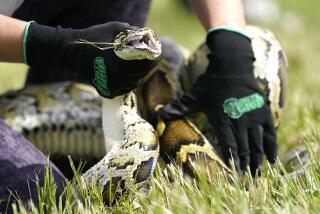South Florida cold snap puts squeeze on pythons
- Share via
Reporting from Fort Lauderdale, Fla. — Vultures circled over Everglades National Park’s Anhinga Trail, where thousands of dead nonnative fish floated in the marshes.
About half of the Burmese pythons that have turned up in the park recently have been dead.
Dead iguanas have dropped from trees onto patios across South Florida.
And in western Miami-Dade County, three African rock pythons -- powerful constrictors that can kill people -- have turned up dead.
Although South Florida’s warm, moist climate has nurtured a vast range of nonnative plants and animals, a January cold snap reminded these intruders that they’re not in Burma or Ecuador anymore.
Temperatures in the 30s have apparently killed Burmese pythons, iguanas and other marquee names in the state’s invasive species zoo.
“Anecdotally, we might have lost maybe half of the pythons out there to the cold,” said Scott Hardin, the Florida Fish and Wildlife Conservation Commission’s exotic species coordinator. “Iguanas definitely. From a collection of observations from people, more than 50% fatality on green iguanas. . . . Lots of freshwater fish died; no way to estimate that.”
Nonnative fish that have infested the Everglades are turning up dead in the thousands, including the Mayan cichlid, walking catfish and spotfin spiny eel, said David Hallac, chief biologist at Everglades National Park.
No one knows how many Burmese pythons live in the Everglades, where some were released as unwanted pets and others found refuge after hurricanes destroyed their breeding sites. But there are a lot fewer today than there were a month ago.
Greg Graziani, a police officer who owns a reptile breeding facility, is one of several licensed python hunters who stalk snakes in the Everglades. In four days, he found two dead snakes, two live ones and one on the verge of death.
“Vultures had pecked through 12 inches by 4 inches down the back of this animal’s body,” he said. “I thought it was dead, and we reached down to pick it up, and it was very much alive.”
In cold weather, Graziani said, pythons go into a catatonic state, and if they don’t make it to a safe place to ride out the weather, they freeze to death.
“We’re finding the smaller pythons are handling it better than the large ones,” Graziani said. “The smaller ones can get into different cracks and crevices to maintain the temperatures they need.”
More to Read
Sign up for Essential California
The most important California stories and recommendations in your inbox every morning.
You may occasionally receive promotional content from the Los Angeles Times.










